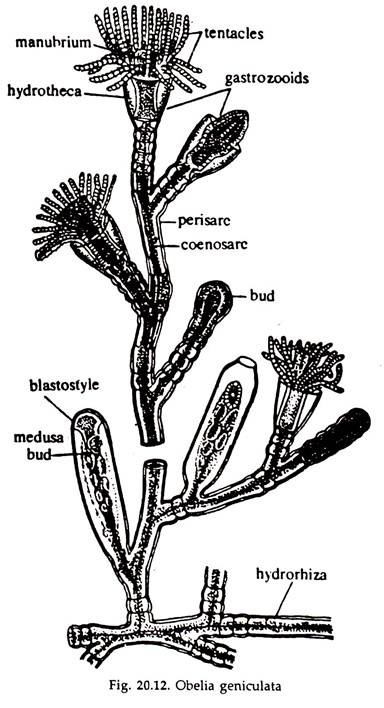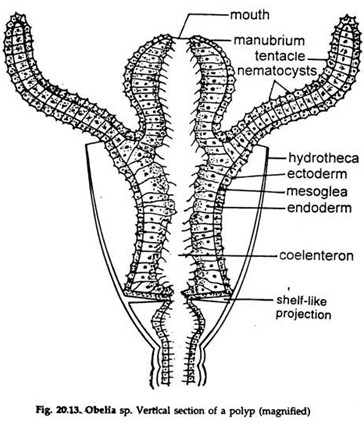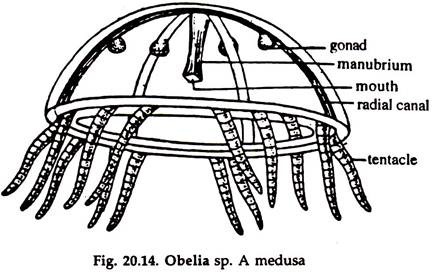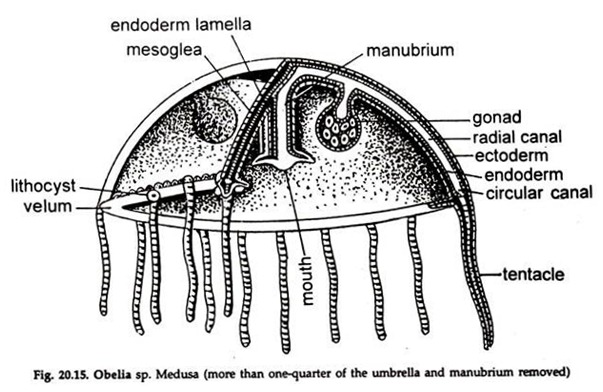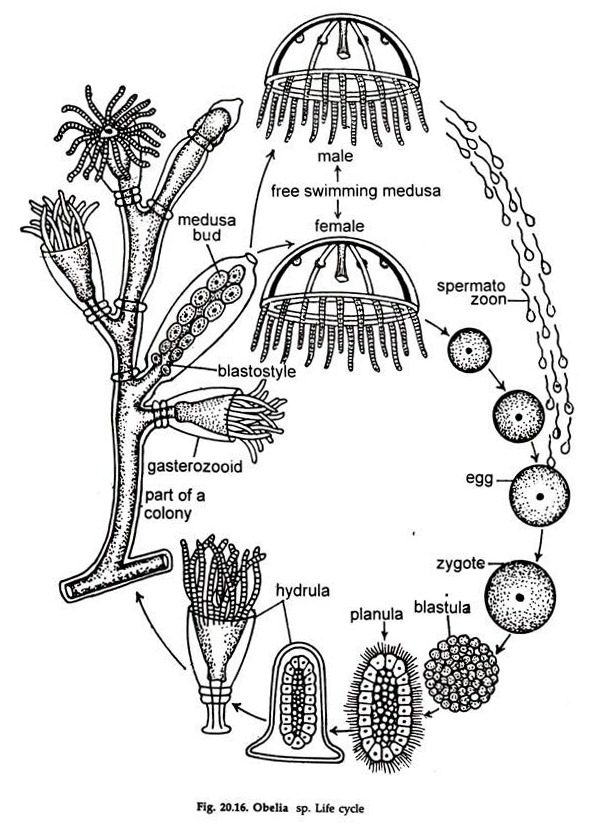In this article we will discuss about the life cycle of obelia, explained with the help of suitable diagrams.
Description of Obelia:
1. It is a branched, fixed colony (Fig 20.12). Some of the horizontal branches anchoring the colony on some support are called Hydrorhiza while other branches are vertical and known as Hydrocaulus.
2. Each branch consists of a granular coenosarc made of two cell layers enclosing the coelenteron and surrounded by a thin transparent horny perisarc.
ADVERTISEMENTS:
3. The vertical branches towards the base are further branched and all the branches end in zooids.
4. Zooids are of three types:
a. Polyps or gastro zooids (vegetative zooids). Barrel-shaped and responsible for the nutrition of the colony. The perisarc enclosing the polyp is termed hydro theca.
b. Blastostyles. or gonozooids. Club- shaped zooids, bearing the medusae buds.
ADVERTISEMENTS:
c. Medusae buds. Umbrella-like reproductive zooids bearing gonads, enclosed in a gonotheca.
5. Medusae buds are unisexual and free- living at maturity. One medusa bears either four testes or four ovaries close to the four radial canals.
6. The tentacles in all cases are solid; the solid core or endoderm surrounded by a layer of ectoderm cells.
7. The larvae are ciliated and free-swimming.
ADVERTISEMENTS:
8. By repeated branching of the simple polyps colony is formed.
Polyps or Gastro zooids or Nutritive Zooids:
1. The zooid is barrel-shaped, partially enclosed by a cup-shaped hydro theca, a continuation of the perisarc.
2. At the distal end a conical projection the hypostome or- manubrium, bearing a mouth is present (20.13).
3. A circlet of about twenty-four tentacles are present around the hypos tame. The tentacles are solid with a core of endoderm cells surrounded by a layer of ectodermal cells.
4. The tentacles and the hypostome bear cnidocytes.
5. At the proximal end, the zooid is continuous with the coenosare.
Blastostyle or Gonozooid or Reproductive Zooid:
1. These are a few in number and restricted to the basal end of the hydrocaulus.
2. The blastosyle is long, cylindrical and devoid of mouth and tentacles and enclosed in a transparent gonotheca, modified perisarce (Figs. 20.12, 20.16).
ADVERTISEMENTS:
3. A number of small buds—the medusae buds develop on the walls of the blastostyle.
Medusa in Obelia:
1. At maturity, small umbrella-like me dusae buds get detached from the blastostyle and escape to the sea water through an aperture at the free end of the gonotheca. A hydro-medusa (Fig.20.14) is a solitary and free-swimming modified zooid.
2. A typical medusa consists of a bowl- shaped gelatinous disc or umbrella, the concave surface of which is described as sub-umbrella and the outer convex surface as ex-umbrella.
3. A cylindrical projection, the manubrium, hangs from the middle of the subumbrellar surface. A square mouth is present, at the apex of the manubrium.
4. The mouth leads to a small, central, rounded or quadrangular chamber known as gastric cavity or stomach.
5. From gastric cavity four gastro dermal canals radiate to the margins of the bell. These are radial canals, opening into a ring canal or circular canal running in the margin of the bell. The radial canals mark out four principal radii.
6. From the middle of the radial canal four gonads project. Since sexes are separate, these are either testes or ovaries.
7. The gonads mature after the medusae escape from the gonotheca.
8. The edge of the bell is produced inwards as a thin fold called velum. The medusae with a velum are known as craspedote and those without a velum are acraspedote. The hydromedusa is craspedote.
9. From the edge of bell numerous small solid tentacles hang downwards.
10. The tentacles have swollen bases of accumulated interstitial cells, called vesicles or bulbs. Cnidocytes are formed continuously in the bulb and migrate to the tentacles. They are confined to manubrium and tentacles and a few on the bell margin.
11. Near the bulbs the ectoderm has pigment granules and nerve cells called ocelli. The pigments are accumulated excretory products.
12. Marginal sense organs, statocysts or lithocysts are eight in number and attached at regular intervals on the subumbrellar side to the bulbs of the tentacles.
13. A statocyst is a tiny, circular, closed vesicle lined with ectoderm and filled with a fluid containing calcareous granules called otoliths.
14. Otolith produces a stimulus on thin sensory processes of the sensory tells of ectodermal lining which are transmitted to the muscles. The muscles coordinate the snake-like swimming movements of the medusa.
Histology of Hydromedusa (Fig. 20.15):
1. Both exumbrellar and subumbrellar surfaces of medusa are covered by ectoderm cells.
2. The whole canal system is lined by endoderm cells, continued, at the lip of the mouth, into the surface ectoderm.
3. A thin sheet of endodermal lamella, presumably formed by the fusion of an upper and a lower layer of endoderm, lie between the radial canals and between the ex- and subumbrellar layers of ectoderm.
4. The velum is composed of a double layer of ectoderm enclosing a ring canal and a strip of narrow mesoglea in between the canal and ectoderm.
5. The tentacles are solid, each containing a core of vacuolated endodermal cells covered by ectoderm.
6. The gelatinous mesoglea form the main bulk of the body and contains certain non-cellular fibres.
7. Well-developed musculature with regularly arranged circular, longitudinal and radial tracts is present.
8. The interstitial cells are mainly accumulated at the bulbs or vesicles of tentacles and give rise to cnidocytes of only one type.
Gonads:
1. The medusae are sexual reproductive zooids or gonozooids possessing gonads.
2. They are dioecious—testes and ovaries are borne by separate individuals.
3. Each medusa bears only four gonads situated on the subumbrellar surface, one on the middle of the course of each radial canal.
4. The gonads mature after the medusae escape from the gonotheca.
5. Each gonad (testis or ovary) is an ovoid, knob-like body; it has an outer covering of ectoderm, continuous with that of the sub-umbrella, and an inner lining of endoderm continuous with that of the radial canal (Figs. 20. 14, 20.15)
6. The space between the two layers is filled with a mass of interstitial cells which become differentiated into ova or sperms, as the case may be.
7. The germ cells originate in the ectoderm of the manubrium quite early when the medusa itself remains attached to the blastostyle.
8. Subsequently, they migrate to the gonads to lie between the mesoglea and the subumbrellar ectoderm and undergo maturation.
9. When the gonads are ripe, ectodermal covering ruptures and the germ cells are shed in water.
10. The ova are large rounded cells.
11. The sperms are minute, actively swimming flagellated cells.
12. The medusae die soon after liberating the gametes.
Fertilization and Development in Obelia:
1. Fertilization occurs either in the sea water where the germ cells are set free, or the spermatozoa may be carried by water currents to the female medusae and fertilize the ova in situ. Zygote formed after fertilization, immediately undergoes cleavage.
2. The cleavage is holoblastic and a blastula is formed (Fig. 20.16).
3. By invagination the blastula is converted into an oval, ciliated planula larva.
4. The planula consists of an outer layer of ciliated ectoderm and an inner mass of endoderm cells enclosing a space, the rudiment of coelenteron.
5. The planula swims freely for a brief period and settles down on some submerged substratum by one end.
6. The proximal end gradually narrows down and a disc appears for attachment. The distal end expands and by developing a manubrium and a circlet of tentacles, it turns to a hydrula or simple polyp.
7. The hydrula sends out lateral buds and, by a repetition of this process, it is converted into a complex obelia colony.
Alternation of Generations of Obelia:
A distinct alternation of generations or metagenesis is present in the life history of Obelia. The Obelia colony is sexless, bears no gonads and develops by asexual process, i.e. by repeated budding of the hydrula.
But the medusae buds, some of the zooids of the colony, develop gonads and, from their fertilized egg, new Obelia colony arises. The asexual generation is dependent on, and is alternated by the sexual generation.
Obelia is a permanently fixed colony but the planula larvae it produces are free swimming. The larva can swim from place to place with the help of cilia and, being aided by water current, it can travel a long distance. Thus, a non-locomotory species becomes locomotory and an overcrowding of individuals within a limited area is avoided and, thereby, the species is successfully continued.
